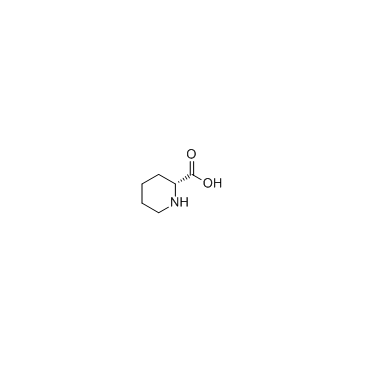H-D-HomoPhe-OH

H-D-HomoPhe-OH structure
|
Common Name | H-D-HomoPhe-OH | ||
|---|---|---|---|---|
| CAS Number | 1723-00-8 | Molecular Weight | 129.157 | |
| Density | 1.1±0.1 g/cm3 | Boiling Point | 265.8±33.0 °C at 760 mmHg | |
| Molecular Formula | C6H11NO2 | Melting Point | 272ºC(lit.) | |
| MSDS | Chinese USA | Flash Point | 114.5±25.4 °C | |
| Symbol |

GHS07 |
Signal Word | Warning | |
|
A gas chromatographic--mass spectrometric study of profiles of volatile metabolites in hepatic encephalopathy.
J. Chromatogr. A. 226(2) , 291-9, (1981) Volatile organic substances present in blood plasma and cerebrospinal fluids of certain control groups of human subjects and cirrhotic patients some of whom were suffering from hepatic encephalopathy were quantitatively analysed and identified. A rapid, repro... |
|
|
[Association of plasma ammonia and GABA levels and the degree of hepatic encephalopathy].
Rev. Invest. Clin. 44(4) , 483-90, (1992) Several toxic factors have been implicated in the pathogenesis of hepatic encephalopathy (PSE) among which ammonia plays a dominant role. More recently, the gamma-aminobutyric acid (GABA) hypothesis in which an increase in the GABA-ergic tone and the presence... |
|
|
Plasma levels of pipecolic acid, both L- and D-enantiomers, in patients with chronic liver diseases, especially hepatic encephalopathy.
Clin. Chim. Acta 287(1-2) , 99-109, (1999) Pipecolic acid is regarded as a gamma-aminobutyric acid receptor agonist. Stereochemical studies of pipecolic acid were performed in patients with chronic liver diseases. Plasma D- and L-pipecolic acid were significantly elevated in 15 liver cirrhotic patient... |
|
|
Plasma 3-methylbutanal in man and its relationship to hepatic encephalopathy.
Clin. Physiol. 5(1) , 53-62, (1985) 3-Methylbutanal is a volatile aldehyde which in the rat is derived, at least in part, from colonic bacterial breakdown of leucine. It has been proposed as a toxin of importance in the pathogenesis of hepatic encephalopathy in man. A rapid, reliable and highly... |
|
|
Three-dimensional quantitative structure-activity relationship analyses of substrates of the human proton-coupled amino acid transporter 1 (hPAT1).
Bioorg. Med. Chem. 19 , 6409-18, (2011) The proton-coupled amino acid transporter hPAT1 has recently gained much interest due to its ability to transport small drugs thereby allowing their oral administration. A three-dimensional quantitative structure-activity relationship (3D QSAR) study has been... |
|
|
Comparison of serum and urinary levels of modified nucleoside, 1-methyladenosine, in cancer patients using a monoclonal antibody-based inhibition ELISA.
Tohoku J. Exp. Med. 176(1) , 61-8, (1995) To evaluate the clinical usefulness of serum 1-methyladenosine, several modifications have been made in our previously established inhibition ELISA system. Horseradish peroxidase (HRP) labeled anti-mouse IgG and 3,3',5,5'-tetramethylbenzidine (TMBZ) were used... |
|
|
Lysine catabolism in Haemonchus contortus and Teladorsagia circumcincta.
Exp. Parasitol. 131(1) , 101-6, (2012) Catabolism of lysine through the pipecolate, saccharopine and cadaverine pathways has been investigated in L3 and adult Haemonchus contortus and Teladorsagia circumcincta. Both enzymes of the saccharopine pathway (lysine ketoglutarate reductase (LKR) and sacc... |
|
|
Effect of a carboxyl group on the chemiluminescent reaction of tris(2,2′-bipyridine)ruthenium(III) with aliphatic amines
Talanta 78(1) , 227-32, (2009) The effect of a carboxyl group beside nitrogen of aliphatic amines on the tris(2,2′-bipyridine)ruthenium(III), Ru(bpy) 3 3+, chemiluminescent reaction was examined. It has been shown that a carboxylate anion promotes the chemiluminescent reaction at a lower p... |
|
|
Determination of pipecolic acid following trimethylsilyl and trifluoroacyl derivatisation on plasma filter paper by stable isotope GC-MS for peroxisomal disorders.
Arch. Pharm. Res. 33(2) , 317-23, (2010) If early diagnosis is not made, patients with peroxisomal disorders rapidly progress to sudden death, physical defect or mental retardation resulted in storage of the toxic material into the brain. Therefore, it is necessary to develop the analytical method f... |
|
|
Lysine restricted diet for pyridoxine-dependent epilepsy: first evidence and future trials.
Mol. Genet. Metab. 107(3) , 335-44, (2012) To evaluate the efficacy and safety of dietary lysine restriction as an adjunct to pyridoxine therapy on biochemical parameters, seizure control, and developmental/cognitive outcomes in children with pyridoxine-dependent epilepsy (PDE) caused by antiquitin (A... |